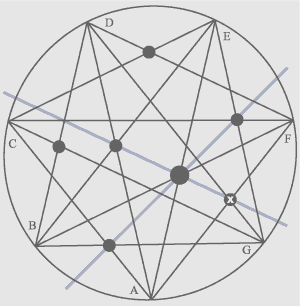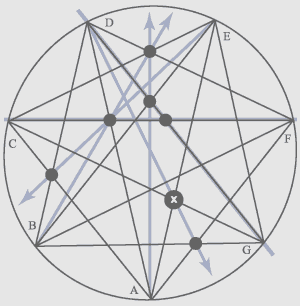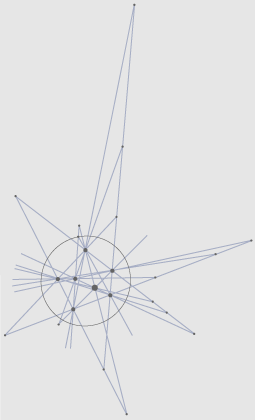The real garden of stones occupies some space and has borders which can be
different forms and the sizes depending on the location of a garden. Accordingly
the heptagonal geometrical network of lines should be coordinated with the sizes
of available space and prospective borders of a created Japanese garden of stones.
If the space is limited then the heptagonal network of lines can reach outside
available space, and borders of a garden can occupy a part of a heptagon, namely
borders of a garden can occupy within the framework of a heptagonal network of
lines only a part which is within the limits of available space. Thus the
arrangement of stones should be coordinated with lines of a heptagon, and also
it is necessary to find possible points of contemplation which coincide with
apexes of a heptagon and are within the limits of available space.
If the space is not limited then the heptagonal network of lines can be
completely placed within the limits of available space, namely it is possible to
construct the perfect stone garden which has seven points of contemplation and
has borders equal to a heptagon.
The sizes of a heptagon can be different, that depends on a concrete place, but
the more sizes the more perceived and apparent space of a Japanese garden of stones.
If within the limits of measured geometrical network there are any
appreciable plants then these plants should be coordinated with lines. Or in
space of a garden it is possible to put the plants coordinated with
geometrical network of lines though plants do not correspond to traditional
conceptions of the Japanese garden of stones.
It is possible to use a combination of traditional Japanese garden of stones in
which there are located stones, with the
concept of European garden in which there are plants provided that stones and
plants should be coordinated with general geometrical network of lines.
The garden can be focused concerning any point of contemplation in any certain
direction. Correct is direction to the north as in this case the sun
does not blind eyes in midday that allows to see objects of a garden. Or it is possible
to choose other directions which means evening or morning contemplation of a
garden. Namely it is possible to focus the Japanese garden of stones differently
and to coordinate lines of a heptagonal network with environmental space, to
have necessary points of contemplation.
I can not list all nuances which can arise during creation of the Japanese
garden of stones on any concrete place within the limits of this or that
concrete space, but I bring to your attention possible charts for realization of
the perfect stones garden which occupies unlimited space and has seven points of
contemplation that allows to see stones of a garden from the different sides and
allows to choose different points for observation of a garden in different time.
| Garden of stones (variant
1st): composition of a Japanese garden: 
Garden of stones (variant 2nd): Garden of stones (variant 3rd):  |
Compositions of a Japanese garden. Offered variants of a perfect Japanese garden of stones consist of
seven stones (objects) and are organized according to a heptagonal
geometrical network of lines that is shown on charts: The first variant of the perfect Japanese garden
distinguishes that all stones are located on different lines of geometrical
network, namely on each line is located no more than one stone (any two
stones are not on one line). It means that from each point of
contemplation it is possible to see all stones. The second variant of the perfect Japanese garden distinguishes that all stones
can be seen from the point of contemplation F, and from other points of
contemplation any one stone is not seen, that is shown on the chart by
grey arrows and lines. The third variant of the perfect Japanese garden distinguishes that from all
points of contemplation any one stone is not seen, and from the point of
contemplation D it is not visible two stones that is shown on the
chart by grey arrows and lines. The listed variants show some opportunities which can be embodied
as a result of creation of Japanese garden of stones, but there are
many variants in which various geometrical laws and ratio can be ciphered. |
If to look the first variant of a garden of stones and to draw imagined lines which connect stones and proceed outside a heptagon then in the long term some of these lines form points of crossings where external objects of a Japanese garden of stones can be located. Namely these points of crossings can be adhered to any external objects or can be purposely designated by external objects which can be arranged in these points. Or according to external objects it is possible to search for the most probable locations of stones, namely it is possible to adjust coordinate systems of district with lines of a heptagonal geometrical network according to which stones will are located, that is shown on the chart:
 |
The chart shows the first variant of a stones garden: - dark circle designates borders of a heptagonal geometrical network where the stones designated by dark points; - grey lines show imagined visual lines which connect stones; - small dark points show crossings of imagined visual lines where external objects can be located. Distant points of crossings of imagined visual lines can designate the maximal borders of a park in which the Japanese garden of stones is located, that on the chart corresponds to a grey rectangular. In total creation of a Japanese garden of stones can be a multilevel task in which many aspects can be taken into account, and including the arrangement of stones can be coordinated with features of district which surrounds a garden and forms prospect. As a result of correct geometrical measurements and the verified geometrical ratio it is possible to generate harmonious space where the man can find points of contemplation allowing to see and feel harmony of world around. |
Besides in any environmental space it is possible to search for points of contemplation where the world around is perceived most harmoniously. Namely by means of geometrical measurements it is possible to investigate natural landscapes and to solve the geometrical puzzles existing in ratio of objects, to find out structure of a nature and to find points for harmonious perception of the world.
The following page describes chronological laws of time which can be seen in lines of a heptagonal geometrical network, and also in arrangements of stones of a Japanese garden within the framework of a heptagonal geometrical network.